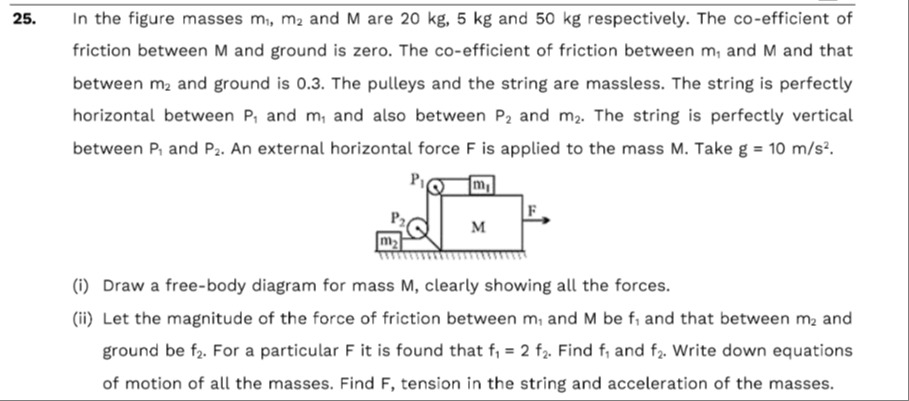Question
Question: In the figure masses m₁, m₂ and M are 20 kg, 5 kg and 50 kg respectively. The co-efficient of fricti...
In the figure masses m₁, m₂ and M are 20 kg, 5 kg and 50 kg respectively. The co-efficient of friction between M and ground is zero. The co-efficient of friction between m₁ and M and that between m₂ and ground is 0.3. The pulleys and the string are massless. The string is perfectly horizontal between P₁ and m₁ and also between P₂ and m₂. The string is perfectly vertical between P₁ and P₂. An external horizontal force F is applied to the mass M. Take g = 10 m/s².
(i) Draw a free-body diagram for mass M, clearly showing all the forces.
(ii) Let the magnitude of the force of friction between m₁ and M be f₁ and that between m₂ and ground be f₂. For a particular F it is found that f₁ = 2 f₂. Find f₁ and f₂. Write down equations of motion of all the masses. Find F, tension in the string and acceleration of the masses.

f₁ = 30 N, f₂ = 15 N, T = 18 N, a = 0.6 m/s², F = 96 N
Solution
Understanding the Problem
We have a system of three masses connected by a string and pulleys. The goal is to determine the friction forces, tension in the string, acceleration of the masses, and the applied force F.
Step-by-Step Solution
-
Free Body Diagrams (FBDs)
- m₁ (on M): Tension T acts to the left, friction f₁ acts to the right.
- m₂ (on ground): Tension T acts to the right, friction f₂ acts to the left.
- M (50 kg): External force F acts to the right, friction f₁ acts to the left, and tension 2T acts to the left (due to two pulleys).
-
Newton's Laws
- For m₁: 20(a + α) = f₁ – T (1)
- For m₂: 5(a + α) = T – f₂ (2)
- For M: 50a = F – (f₁ + 2T) (3)
-
String Constraint
Assume m₁ does not slip with respect to M (α = 0), so a_{m₁} = a and a_{m₂} = a. Then (1) and (2) become:
- 20a = f₁ – T (1a)
- 5a = T – f₂ (2a)
-
Given Relation
f₁ = 2f₂. Since m₂ is sliding, f₂ = μ(5g) = 0.3 * 5 * 10 = 15 N. Thus, f₁ = 2 * 15 = 30 N.
-
Solve for T and a
From (2a): T = 5a + 15. From (1a): 20a = 30 – T => T = 30 – 20a. Equating the two expressions for T: 30 – 20a = 5a + 15 => 25a = 15 => a = 0.6 m/s². Then T = 5 * 0.6 + 15 = 18 N.
-
Solve for F
Using (3): 50a = F – (f₁ + 2T) => 50 * 0.6 = F – (30 + 2 * 18) => 30 = F – 66 => F = 96 N.
Final Answers
- f₁ = 30 N
- f₂ = 15 N
- T = 18 N
- a = 0.6 m/s²
- F = 96 N
